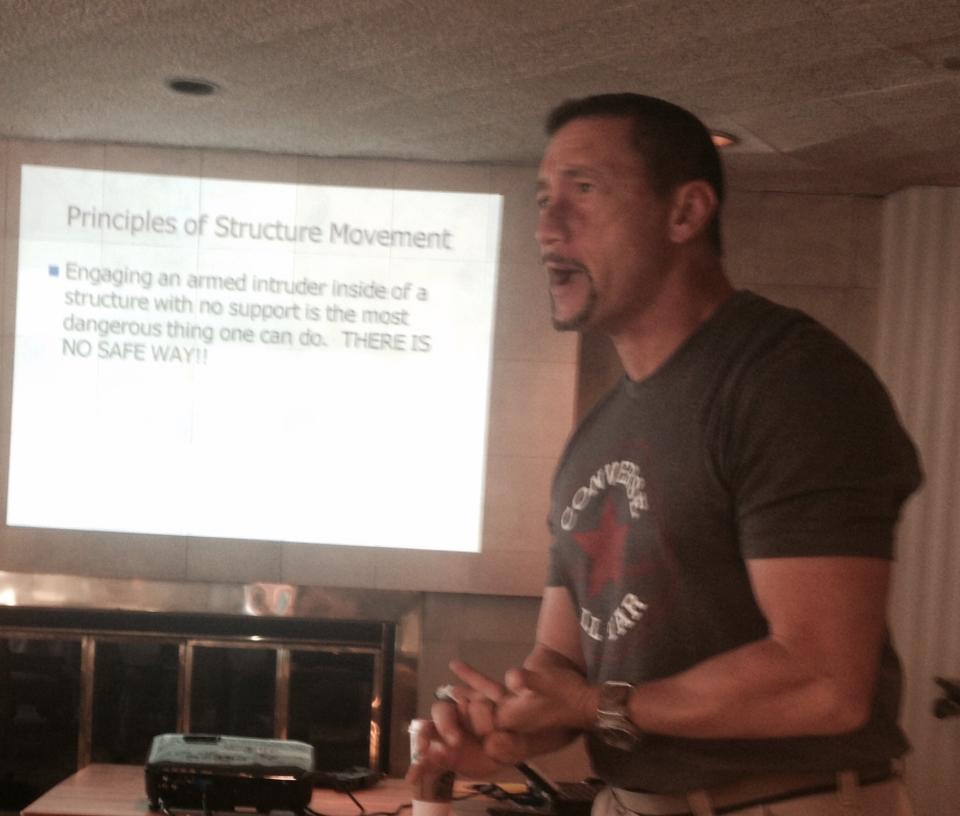Last weekend my lovely rock star sister in law Christa attended Shivworks Armed Movement in Structures (AMIS) designed and taught by Craig Douglass. The class was brought to Pittsburgh by Antifragile Training. Christa was nice enough to write the course review shared below.
Just finished taking the Shivworks Armed Movement In Structures (AMIS) course designed and taught by Craig Douglas and co-taught and hosted by Shawn Lupka. This was a 20+ hour block of instruction covering a solo approach to navigating a structure with a firearm. In other words - how to check your house with a gun and a flashlight when something goes bump in the night. Students included military, law enforcement, professional security, one former pro MMA fighter, and myself. Full disclosure: I’m Shawn’s sister.
The site that Shawn secured was an abandoned country club just outside of the city of Pittsburgh that still contained most of its original furnishings. We met there at 8am and were able to set up a “class room” area in “the mixed grill” - a former restaurant with enough comfortable seating and tables for all 20 participants and their piles of gear. We had 4 unique courses to navigate including a locker room with bathroom stalls, an office area with a long hallway and opposing doorways, a ballroom, and an industrial kitchen.
The course started off with a short but succinct power point presentation beginning with the simple fact that there’s no safe way for a single individual to engage an armed intruder in a structure. This course was designed to teach us how to suck less at this task if we ABSOLUTELY HAD to do it. I really appreciated taking the time to explicitly recognize the difficulty and danger of the situation. All too often people are led to believe there is a magic cure for potentially deadly situations, which can only endanger them further.

Next we went over the geometry of structures and the way vision works within those geometries. We were given physical demonstrations using the angles, recesses, and entryways into the Mixed Grill. The most important takeaways were to always seek depth from a visual impediment and to view an environment in terms of what you can NOT see. The body should conform to the plane of visual impediment (line yourself up with doorways.) Determine which threats are closest and make odds based decisions on what to sweep first with your gun/eyes. Hips should always face direction of travel even when eyes need to be averted to scan for threats. We were to use these tools in order to narrow the field of threat (how much of the 360° circle around us could hide a bad guy) to less than 90°
Now that the short powerpoint was over we were given a basic group exercise. Craig drew a map on a whiteboard and had several students approach to describe the path they would take to clear the mapped structure and how they would do it in terms of choosing a path, “pieing” doorways, and modulating pace. If I’m explaining this coherently please do not get the mistaken impression that I understood what we were talking about at the time! I was, at this point, terribly confused and nervous that I might be called up to the white board. Luckily I was relieved to see that some of the people who did complete part of the exercise seemed just as confused and hesitant as myself and that Craig patiently guided them through the decision making process.
That was the total classroom instruction - it was brief, succinctly covered most of the material we would implement over the weekend, and left me with the sinking feeling that I was in over my head with a complex problem that probably required a variety of prerequisites nearly everyone else seemed to have.
Following that we separated into 4 groups each sent to one of four possible courses Craig & Shawn had mapped out. Each group cycled through each course gradually adding layers of difficulty to the task. This began with walking the route one at a time practicing our ability to navigate the space, taking the most depth from visual impediments, noting the number of exposures, narrowing the field of threat, and using appropriate pacing. Craig or Shawn were often following behind to give manageable bits of instruction to incrementally improve performance (take smaller steps here, increase pace there, tuck your elbow in) It progressed through having teammates hide throughout the courses, to having those hidden teammates shoot back with SIRT guns (they shoot a laser pointer), to having them shoot back with airsoft guns, to mixing in “non-shoot” innocent bystanders.
“Lights draw vision, lights draw fire” - Southnarc
As darkness fell the lights were extinguished and it was time to practice flashlight skills. We were warned against pairing the flashlight with the pistol, which would effectively draw a center mass target on ourselves. Instead Craig showed us how to hold the flashlight away from our body and alternate placement & direction of the light in a series of short bursts by which we could take “snapshots” of vision. He demonstrated how this technique makes it difficult to determine the source of the light and how you can buy yourself time, blind those hiding in the dark, and obfuscate the direction you’re coming from.
All of this coalesced into a final scenario where there was one stationary shooter, one free-moving attacker, and two moving “no-shoots.” My task was to eliminate both of the baddies without harming the innocent bystanders, in the dark. Surprisingly this task seemed easier than many of the earlier missions. The dark is more forgiving of a misstep around highly accurate shooters and the flashlight stuff is INCREDIBLY effective. The day ended at 11pm… a 15 hour day full of getting shot. It was clear to me at this point that Craig’s first slide was on point.
Day two toned down the video game violence as we began to focus us on no-shoot scenarios. We started to contextualize the training - someone in your house could be there to murder you… But; they could also be a drunk who thought he was in his own house, a 16 yr old boy who got the address wrong of the girl he was sneaking in to see, or a drug-addled thief who deserves no sympathy but doesn’t really need to be shot… yet. We started with a loud commanding “STOP” and an instruction to put your hands up.
The very first thing to do with a compliant hands-up criminal is make them face away from you. If they do decide to get frisky it will take an extra step to orient themselves towards you. Next we checked their waistline for weapons. We did this by instructing them to pull their shirt up over their heads until we could see their waistband. This also served the purpose of keeping their hands occupied, away from their waist, and covering their eyes.
Craig instructed us that the safest thing for an individual to do with a home invader or a criminal at gunpoint is to “pin them” and wait for the police. This involved simple verbal commands to assume a posture that would be difficult to suddenly attack from (on knees, ankles crossed, sitting on feet, shirt pulled over their face, leaning forward.) This also involved instructions to be aware when officers approach and make sure your firearm is away before they enter the scene. The best case is to have the bad guy between yourself and the cops when they arrive so that they see him first.
There was also instruction of the best way to disarm the intruder if there is something tucked into his waist, and both attached and unattached ways to move them (though all of those were advised against unless absolutely necessary.) We also covered when and how to bypass a known threat (someone screaming for help in another room/horizontal elbow shield and gun at the 2 position and charge), the safest way to run while holding a firearm (arm straight down and pulled tight to the body and of course a high register position) and pulling the firearm back to presentation as we enter the threat zone from a run. Each description was given context and examples from Craig’s professional experience which illustrated that his technique is reality-based and effective and also served to entertain. For each new module we broke up into our groups and drilled repetitions of the task.
After lunch we were given our final evolution - and I went first so that I could roleplay a character for the remaining students’ evolutions.
My final evo:
I’ve been informed that the final Evolution for AMIS is always the same - so I’m not going to lay out specific details. I was taken to a set of rooms and given a scenario by Craig. The scenario as it was laid out made it entirely possible that absolutely nothing was wrong and that at any moment of clearing this part of the structure I would be faced with someone I would not want to shoot.
It started off well except that my heart was pounding in my chest. I began to work the environment the way we had done on the first day and just tried to keep in mind my brother’s advice about this evo
“Keep calm and make intelligent decisions.” - Shawn Lupka
Things I failed to do: clear a good chunk of one of the rooms, get a ‘Don’t Shoot… Yet.” to pull his t-shirt far enough over his face to actually see his waist, drop my gun to the safe running position, pull the firearm back to presentation before clearing a doorway from a run, cross the threshold of a doorway in order to narrow the field of threat, remember the sequence of events that had just happened after the evo was completed. (I seem to remember now. Adrenaline messes with memory)
Things I am surprised that I did: fired accurately without hesitation, remember and use the correct sequence of verbal commands for a ‘Don’t Shoot… Yet”, not panic.
Things I learned and used reasonably well: Moving quietly, pieing doorways, the 2 position and horizontal elbow shield, increasing pace when moving through a field of threat greater than 90°
When I finished at first I thought I had done a horrible job - though Craig assured me I had done pretty well, especially for my first try with no related experience. After getting to roleplay for the rest of the scenarios I realize I actually DID do pretty well. All things considered, with no prior related training I neutralized multiple threats, did not harm or keep my muzzle on a no-shoot, and took 4-6 probably non-lethal hits to the shoulder, arm, and leg (not counting rounds I took from a roleplayer who didn’t realize he was supposed to “die” after several rounds to the sternum.)
Most of the other students made many of the same mistakes I had made, and many of them made mistakes that I had not made. Although most of them more or less succeeded - the difference was often how long it took and how messy it was. When AMIS tools were utilized effectively the scenario was ended quickly and tidily. In the end I can’t believe how much practical skill I actually gained in the course of one weekend and I think AMIS should be required material for any individual who owns a handgun for home protection.



